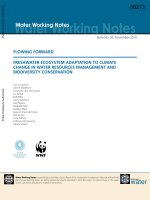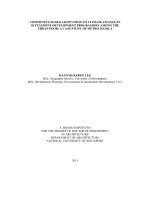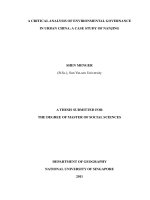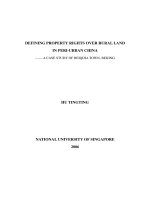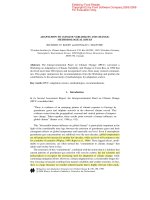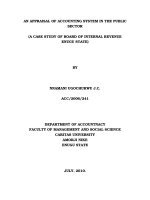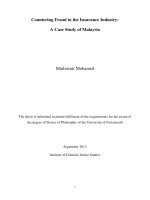Community based adaptation to climate change in settlement development programmes among the urban poor a case study of metro manila
Bạn đang xem bản rút gọn của tài liệu. Xem và tải ngay bản đầy đủ của tài liệu tại đây (6.71 MB, 379 trang )
COMMUNITY-BASED ADAPTATION TO CLIMATE CHANGE IN
SETTLEMENT DEVELOPMENT PROGRAMMES AMONG THE
URBAN POOR: A CASE STUDY OF METRO MANILA
HANNAH KEREN LEE
BSc. Geography (Hons.), University of Birmingham
MSc. Development Planning: Environment & Sustainable Development, UCL
A THESIS SUBMITTED
FOR THE DEGREE OF DOCTOR OF PHILOSOPHY
IN ARCHITECTURE
DEPARTMENT OF ARCHITECTURE
NATIONAL UNIVERSITY OF SINGAPORE
2013
National University of Singapore
DECLARATION
I hereby declare that this thesis is my original work and it has been written by
me in its entirety. I have duly acknowledged all the sources of
information, which have been used in the thesis.
This thesis has also not been submitted for any degree in any university
previously.
Hannah Keren Lee
1 August 2013
National University of Singapore
PhD Thesis Acknowledgements
Hannah Keren Lee
National University of Singapore
i
Acknowledgements
This thesis, although officially the work of one person – the author, contains the
valuable input from many people. I would like to thank and acknowledge them here.
Firstly, my husband: thank you for your unending love and support, and most notably
for enduring the months apart this PhD has necessitated. Secondly, my newborn son:
your imminent birth gave me wonderful motivation to complete my writing and now
you are here, I thank you for the indescribable joy you bring into every day. Thirdly,
my family: you have prayed for me, loved me, listened to me and comforted me as I
have navigated this PhD process – thank you! Fourthly, my supervisors: thank you
for the time and effort you have put into my research and for the wisdom with which
you have guided the process. To my hosts in the Philippines: thank you for your
generous hospitality and loving care towards me throughout my fieldwork and for
making it such an enjoyable experience. To the organizations and individuals who
participated and facilitated my fieldwork in Metro Manila: thank you for your time,
honesty and openness. You made this research possible. Thank you also to academics
at IIED and the DPU in London; I have appreciated the opportunity to discuss
research ideas with you. Finally, to the Asia Research Institute: thank you for the
scholarship that has enabled me to embark on this PhD.
PhD Thesis Table of Contents
Hannah Keren Lee
National University of Singapore
ii
Table of Contents
Acknowledgements i
Table of Contents ii
Abstract v
List of Tables, Figures, Boxes and Plates vii
1 Introduction 1
1.1 Importance of Research 1
1.2 Research Context 3
1.2.1 Cities and Urbanisation 3
1.2.2 Urban Poverty 4
1.2.3 Climate Change 5
1.2.4 The Development Challenge 7
1.2.5 Adaptation – a Response 9
1.3 Identification of Knowledge Gaps 13
1.4 Thesis Structure 15
2 Research Approach and Methodology 16
2.1 Interdisciplinary Research Approach 16
2.2 Research Problem 17
2.3 Research Questions 18
2.4 Research Aim and Objectives 18
2.4.1 Aim 18
2.4.2 Objectives 18
2.5 Overall Research Design 19
2.5.1 Systems Approach 19
2.5.2 Inductive Approach 21
2.5.3 Research Components 22
2.6 Why the Philippines? 23
2.6.1 Metropolitan Manila 26
2.7 Methods of Data Collection 27
2.7.1 Theory Review of CBA 27
2.7.2 Case Study 28
2.8 Recording of Data 37
2.9 Analysis of Data 38
2.9.1 CBA criteria 40
3 Literature Review of CBA 41
3.1 Historical Evolution of CBA 41
3.1.1 Conferences 43
3.1.2 Donors and Non-Governmental Organisations 48
3.2 Definitions and Meaning 48
3.3 Methodology 50
3.4 Practice of CBA 55
3.4.1 Rural Areas 57
3.4.2 Urban Areas 58
3.4.3 Funding for CBA 65
PhD Thesis Table of Contents
Hannah Keren Lee
National University of Singapore
iii
3.5 Lessons for Urban CBA from Research 67
3.5.1 Assets and Housing 67
3.5.2 Partnerships and Institutional Capacity 69
3.5.3 Trust, Communication and Adaptive Strategies 70
3.5.4 Community Savings and Surveys 72
3.6 Critique, Limitations and Challenges of CBA 72
3.6.1 Critique and Limitations 73
3.6.2 Challenges 78
3.7 Summary 82
4 Theoretical Framework for CBA 84
4.1 Roots 84
4.1.1 Development Theory 84
4.1.2 Adaptation Theory 91
4.2 Key Concepts 100
4.2.1 Development-Related 101
4.2.2 Adaptation-Related 115
4.3 Paradigm 127
4.3.1 Development and Adaptation Continuum 127
4.4 Linkages with Disaster Risk Reduction 131
4.5 Entry Point 133
4.6 Summary 135
5 Context Analyses for CBA within Metro Manila 137
5.1 National and Regional Influences 137
5.1.1 Hydrometeorological Hazards 138
5.1.2 Development Issues 140
5.1.3 National Policy Environment 145
5.2 External Influences 162
5.2.1 International Agreements 162
5.2.2 Donor Funding 167
5.3 Summary 172
6 Analysis of the Case Study in Metro Manila 175
6.1 Profile of Case Study Settlement Development Organisations 175
6.1.1 Case 1 – Gawad Kalinga 175
6.1.2 Case 2 – HomelessPeople’sFederationofthePhilippines,Inc. 177
6.1.3 Case 3 – TAO-Pilipinas 179
6.2 Profile of Case Study Urban Poor Communities 181
6.2.1 Selection of Study Communities 181
6.2.2 Community Histories 182
6.2.3 Community Characteristics 189
6.2.4 Current Climate-Related Hazards and Disasters 195
6.2.5 Community and Household Assets 204
6.2.6 Daily Concerns 208
6.3 Summary 211
7 Application of CBA Criteria to Evaluate the Case Study 212
7.1 Criterion 1: Operates at the community level 212
7.2 Criterion 2: Responds to climate risks in a developmental framework 212
7.2.1 Direct Interventions 213
7.2.2 Indirect Interventions 237
7.3 Criterion 3: Builds upon existing local autonomous adaptation strategies . 244
7.3.1 Changes to Housing 244
7.3.2 Willingness to Move 246
7.3.3 Strategies to Reduce Flood Risk 246
7.3.4 Strategies to Cope with Heat 248
7.4 Criterion 4: Engages community members through participatory methods 251
PhD Thesis Table of Contents
Hannah Keren Lee
National University of Singapore
iv
7.5 Criterion5:Enhancesthecommunity’soptionsanddecision-making power
regarding present and future actions to climate risks 252
7.5.1 Perceived Changes in Weather and their Causes 253
7.5.2 Awareness, Understanding and Importance of Climate Change 254
7.6 Criterion 6: Complements community-based development and DRR work
257
7.7 Criterion 7: Incorporates a futures view into community planning and
development 257
7.8 Criterion 8: Reduces present and future climate risks of a community 258
7.9 Overview of CBA Criteria Assessment 259
7.10 Evaluation of the CBA Process 263
7.11 Summary 266
8 CBA Practice and Theory Reviewed 268
8.1 Implications for CBA Practice within the Case Study Context of Settlement
Development Planning 268
8.1.1 Limitations of CBA Practice in the Case Study 268
8.1.2 Challenges of CBA Practice in the Case Study 272
8.1.3 Recommendations for CBA Practice in the Case Study 280
8.2 The Concept of CBA Revisited 286
8.2.1 Existing Theory 286
8.2.2 Settlement Development Planning – a Form of Urban CBA 296
8.3 Summary 297
9 Conclusion 299
9.1 Key Research Findings 299
9.1.1 Significance of Findings 299
9.1.2 Contribution to Current Knowledge 300
9.2 Main Contributions to Theory 301
9.3 The Research Process 302
9.3.1 Research Limitations 304
9.3.2 Further Research 306
References 308
Appendix A – List of Interview Questions by Category for Case Study 323
Appendix B – Complete List of Interviews 332
Appendix C – Community Information 336
Appendix D – Stakeholder Analysis and Venn Diagrams 343
Appendix E – Case Study Tools 352
Acronyms 356
Glossary 360
PhD Thesis Abstract
Hannah Keren Lee
National University of Singapore
v
Abstract
It is widely accepted that anthropogenic climate change and the impacts thereof have
and will have serious consequences for humanity. Specifically, academics and
development practitioners are raising awareness to the fact that the poor are very
likely to be the most impacted by climate change because of their high vulnerability
and low capacity, and yet they have done the least to cause it. In light of this it is
feared that climate change may undo progress towards development, namely the
millennium development goals. Hence adaptation responses to climate change are no
longer a peripheral accessory but are fundamental and central to achieving
development goals in the future. So much so, that ‘adaptationas development’is a
recognized approach for which Community-Based Adaptation to Climate Change
(CBA) is a good medium.
This thesis sets out doctoral research on the practice of CBA among the urban poor in
the context of settlement development planning (such as slum up-grading and
resettlement). It is rooted in development and adaptation theories, and due to its
interdisciplinary nature straddles the fields of urban planning and architecture, global
environmental change and international development among others. Through context
analyses and case study research in Metro Manila, the Philippines the thesis addresses
a lack of knowledge and research about CBA practice in urban areas, and contributes
empirical support for conceptualising settlement development planning among the
poor as a form of urban CBA. This is particularly demonstrated through direct and
indirect interventions within settlement development programmes that reduce the
vulnerability and exposure and build the adaptive capacity of urban poor inhabitants
to climate risks, such as climate-related hazards and current and future impacts of
climate change.
PhD Thesis Abstract
Hannah Keren Lee
National University of Singapore
vi
CBA criteria and indicators used to assess the case study also indicate areas where
settlement development planning can be strengthened in order to practice urban CBA
more effectively. In this regard, the research sets forth eleven recommendations to
settlement development organizations. For example to recognize the potential to
reduce vulnerability through well designed, planned and climate-proofed housing and
sites, and to build upon synergies that exist between Disaster Risk Reduction (DRR)
initiatives and adaptation to climate change.
Of particular notice, the research finds that in spite of institutional support for
adaptation to climate change at the national, regional and municipal levels and
knowledge of climate change among settlement development practitioners, urban
poor inhabitants have little or no awareness of climate change. For them their
priorities centre on meeting daily needs and responding to immediate climate risks,
namely floods and heat in Metro Manila. This highlights the important role that
settlement development practitioners (including planners, architects and engineers)
can play as channels for conveying knowledge and thus raising awareness about
climate change and associated risks to the urban poor communities they work with.
Secondly, it highlights that climate change will gain prominence among the urban
poor when it noticeably impacts upon their daily needs (such as food, water, work
and housing). And thirdly, it encourages settlement development practitioners and
government to view community-based disaster risk reduction and management
(CBDRRM) initiatives, which are prevalent responses to current climate risks among
settlement development programmes, to be viewed as catalysts and gateways for
more strategic, planned adaptation initiatives. Yet, within this to develop a longer
term, futures view that incorporates climate change consciousness and sensitivity into
planning and goes beyond historic and current climate risks.
Key words: Housing, Settlement Development Planning, Urban Poor, Climate Change,
Climate Risk, Adaptation, Philippines, Flooding
PhD Thesis List of Tables, Figures, Boxes and Plates
Hannah Keren Lee
National University of Singapore
vii
List of Tables, Figures, Boxes and Plates
Table 1. Research Questions 18
Table 2. Research Approach 22
Table 3. Research approach for theory review of CBA and related discourses 28
Table 4. List of the three settlement development organisations and six urban poor
communities in the case study 31
Table 5. Summarised list of government (national, city and town) agencies, NGOs
and academe interviewed using snowball sampling and semi-structured
interview methods during the fieldwork in Metro Manila 33
Table 6. Research approach for examining CBA practice among the urban poor in the
context of settlement development planning 35
Table 7. Categories of questions for different actors within the case study 37
Table 8. Criteria and indicators of CBA practice 40
Table 9. International workshops and conferences on Community-Based Adaptation
to Climate Change (CBA) 46
Table 10. Stages of CBA planning according to various authors 52
Table 11. Examples of methodological tools used according to their purpose and
stage in the CBA process 54
Table 12. Adaptation strategies applied by tenants and owner-occupiers during
rains/floods in Mombasa, Kenya 68
Table 13. Meanings of development over time 86
Table 14. Different types of adaptation 93
Table 15. Characteristics of mitigation and adaptation 93
Table 16. Simplified chronological evolution of development theory, adaptation and
planning between the 1940s and 2000s 99
Table 17. Comparison of CCA and DRR approaches 133
Table 18. Example of donor-funded projects and programmes in the Philippines
garnered from fieldwork interviews 169
Table 19: Locational information for the six urban poor communities in the case
study 182
Table 20. Summary of characteristics for the six study communities 191
Table 21. Most common types of livelihoods in each study community 193
Table 22. Results for resident ranking of (predominantly weather-related) hazards
per study community 201
Table 23. Combined resident ranking for (predominantly weather-related) hazards
from highest to lowest relevance 201
Table 24. Results of resident ranking of household assets per study community 205
Table 25. Combined community results for resident ranking of household assets from
highest to lowest relevance 205
Table 26. Results of resident ranking of community assets per study community 207
Table 27. Combined results for resident ranking of community assets from highest to
lowest relevance 207
Table 28. List of daily concerns and frequency they are identified during resident
interviews in the six study communities 209
Table 29. List of alterations to housing made by community residents following TS
Ondoy in 2009 245
Table 30. List of ways residents in the study communities cope with heat 249
Table 31. Responses by residents in the study communities about climate change . 255
PhD Thesis List of Tables, Figures, Boxes and Plates
Hannah Keren Lee
National University of Singapore
viii
Table 32. Evaluation against CBA criteria of the three study settlement development
programmes in regards to the six study urban poor communities 262
Table 33. Analysis of case study research against key stages of the CBA process 265
Table 34. Complete list of fieldwork interviews carried out between February and
June 2012 335
Table 35. Brookside'scommunityhistoryastoldbyits’residents 336
Table36.SitioPajo'scommunityhistoryastoldbyits’residents 337
Table37.PSHAI'scommunityhistoryastoldbyits’residents 337
Table38.Tagumpay'scommunityhistoryastoldbyits’residents 338
Table 39. Sub-Urban'scommunityhistoryastoldbyits’residents 338
Table 40. Masagana's communityhistoryastoldbyits’residents 339
Table 41. List of livelihoods identified during resident interviews in each of the six
study communities 340
Table 42. A summary of perceived changes in weather among residents of the six
study communities 340
Table 43. A summary of perceived causes of weather changes among residents of the
six study communities 341
Table 44. A summary of perceived causes of flooding among residents of the six
study communities 341
Table 45. A summary of sources of climate change information identified by
residents of the six study communities 342
Table 46. Institutions and actors identified by residents in Brookside 344
Table 47. Institutions and actors identified by residents in Sitio Pajo 345
Table 48. Institutions and actors identified by residents in PSHAI 345
Table 49. Institutions and actors identified by residents in Tagumpay 346
Table 50. Institutions and actors identified by residents in Sub-Urban 347
Table 51. Institutions and actors identified by residents in Masagana 348
Figure 1. A conceptual model of climate change responses 10
Figure 2. Basic systems approach 20
Figure 3. Multi-layered or 'onion-peel' research methodology 20
Figure 4. (Left) Map of Philippines 24
Figure 5. (Right) Location of Philippines in relation to China and Indonesia 24
Figure 6. Illustration of an embedded, multiple-case study design 30
Figure 7. Three types of ties in social capital 103
Figure 8. Ladder of Participation 107
Figure 9. Typology of participation: how people participate in development
programmes and projects 108
Figure 10. The Development and Adaptation Continuum 128
Figure 11. Schematic illustration of the theoretical framework underpinning CBA
theory and practice 136
Figure 12. (Left) Location of study area in relation to the boundary of Metro Manila
182
Figure 13. (Right) Map of community locations in study area 182
Figure 14. Hazard map by residents of Brookside 196
Figure 15. Hazard map by residents of Sitio Pajo 196
Figure 16. Hazard map by residents of PSHAI 197
Figure 17. Hazard map by residents of Tagumpay 197
Figure 18. Hazard map by residents of Sub-Urban 198
Figure 19. Hazard map of current housing at the Fishpond in Navotas by residents of
Masagana 198
Figure20.HazardmapandsiteplanofplannedhousinginMasagana’srelocationsite
in Angat, Bulacan 199
Figure 21. The relationship between support mechanisms and vulnerabilities 214
PhD Thesis List of Tables, Figures, Boxes and Plates
Hannah Keren Lee
National University of Singapore
ix
Figure 22 Drawing of terraced GK row houses in Sitio Pajo, illustrating the air vents
and slatted windows to facilitate passive cooling, raised first floor from street
level, and the plant beds for greening and cooling the community. 217
Figure 23. Drawing of terraced bungalow GK housing in Brookside, illustrating the
drainage channels and slatted glass windows 218
Figures 24 and 25. Front view (left) and rear view (right) drawings of planned
housing in Bulacan for Masagana 222
Figure 26. (Left) Floor plan drawing of planned housing in Bulacan for Masagana 223
Figure 27. Illustration of settlement development planning as a form of urban CBA
296
Figure 28. Venn diagram by Brookside residents during a focus group meeting 349
Figure 29. Venn diagram by Sitio Pajo residents during a focus group meeting 349
Figure 30. Venn diagram by PSHAI residents during a focus group meeting 350
Figure 31. Venn diagram by Tagumpay residents during a focus group meeting 350
Figure 32. Venn diagram by Sub-Urban residents during a focus group meeting 351
Figure 33. Venn diagram by Masagana residents during a focus group meeting 351
Box 1. Key principles of CBA 50
Box 2. Prerequisites for Planned Adaptation 95
Box 3. Hyogo Framework for Action 2005-2015's five priorities 166
Box 4. Exert from the GK-CIPSiteSelectionCriteriafromGK’sBuilder’sManual
226
Box 5. Selection of quotes from residents regarding changes in weather they perceive
254
Box 6. Selection of quotes from residents regarding the meaning and importance of
climate change 256
Plate 1. Some of the picture cards used in the hazard ranking exercise. Clockwise
from top left to bottom left: floods, typhoon, heat, and earthquake. 200
Plates 2 and 3. (Left and right) Residents doing the asset ranking exercise in
Brookside and PSHAI, respectively 204
Plates 4, 5 and 6. (Left to right) Examples of how materials from the House Materials
Loan Program have been used in the Tagumpay community in Brgy. Bagong
Silangan, Quezon City. 215
Plates 7 and 8. (Left and centre) 3D models of retrofitting to be done to (a) door and
window openings and (b) a concrete floor slab 216
Plate 9. (Right) A stabilizer built for the external wall of a house being retrofitted in
Sub-Urban 216
Plates 10 and 11. (Left and right) Front view of GK row houses in Sitio Pajo,
illustrating the air vents and slatted windows to facilitate passive cooling, the
raised first floor from the street level and the plant beds for greening and
cooling the community. 217
Plate 12. (Left) GK terraced bungalow housing surrounding the basketball court in
Brookside 219
Plate 13. (Right) Front of a GK terraced bungalow house in Brookside, illustrating
growing potted plants in the area directly outside the house 219
Plate 14. Row housing in PSHAI 220
Plate 15. Terraced two-storey CLIFF housing in PSHAI 220
Plate 16. Independently built housing in PSHAI 220
Plate 17. A bungalow built through CLIFF in PSHAI 220
Plate 18. (Left) Makeshift single-storey houses on bamboo stilts in Masagana 222
Plate 19. (Right) A three-storey plywood and corrugated iron house on bamboo stilts
in Masagana 222
PhD Thesis List of Tables, Figures, Boxes and Plates
Hannah Keren Lee
National University of Singapore
x
Plate 20. (Right) Aerial view of a model of the planned housing in Bulacan for
Masagana 223
Plates 21 and 22. (Left and right) First batches of cement tiles made by members of
the Masagana community for their housing in the relocation site in Angat,
Bulacan 224
Plate 23. Retaining wall and boardwalk with drainage beneath financed by a CLIFF
community-upgrading loan 228
Plate 24. (Left) Basketball court at Sub-Urban to co-function as a temporary
evacuation centre 230
Plate 25. (Centre) Sub-Urban Phase 1B/1A-2HOA’sCommunityCentre 230
Plate 26. (Right) Metal footbridge in Sub-Urban to be replaced by TAO-Pilipinas
under the TS Ketsana Rehabilitation Program 230
Plates 27 and 28. (Left and right) Concrete rainwater tanks constructed outside houses
in PSHAI 232
Plates 29, 30 and 31. (Left to right) Vertical gardening using containers and plastic
bottles in PSHAI 232
Plate 32. (Left) Community disaster response equipment currently stored in
Brookside’sMulti-Purpose Hall 235
Plate 33. (Right) A flood marker in Santa Clara Street, Brookside as part of their early
warning system 235
Plates 34 and 35. (Left and right) Vines and trees grown by residents in Brookside to
provide shade and cooling for nearby houses 250
Plate 36. (Left) Draped material to shield room from heat radiated from the roof in
Brookside 250
Plate 37. (Right) Reflective insulation material placed underneath a corrugated iron
roof to reduce heat radiation into the house in Sub-Urban 250
Plate 38. (Left) Awning outside door and shrubs outside windows to provide shade
and protection from rain in Sitio Pajo 250
Plate 39. (Right) Plywood ceiling to shield living rooms from corrugate iron roof in
Sub-Urban 250
Plates 40 and 41. Unused building materials accessed by a Tagumpay resident from
HPFPI’sHouseMaterialLoan 269
PhD Thesis Chapter 1
Hannah Keren Lee
National University of Singapore
1
1 Introduction
1.1 Importance of Research
In their book Poverty: A Persistent Global Reality editors Dixon and Macarov (1998)
argue that worldwide poverty persists to exist throughout history to this present day.
At a global scale, we spend tens of billions of dollars every year on international aid
and yet the number of people who are socially, economically, and physically poor is
disconcertingly large. In 2005, 3.14 billion people lived on less than US$ 2.50 a day;
that is equivalent to about 50 per cent of the global population. Furthermore out of 2.2
billion children worldwide 1.9 billion children live in low- and middle-income
nations, of which one in three are without adequate shelter; one in five have no access
to safe water; and one in seven have no access to health services. (Shah, 2010)
An anthropogenic-driven change in climate threatens to worsen the situation. Global
increases in temperature accompanied by changes in weather extremes, intensity and
distribution are expected to increase the vulnerability of the most vulnerable, who are
often the poor, first (Adger, 1995; Huq, Rahman, Konate, Sokona, & Reid, 2003).
This growing fear, that climate change impacts may undermine poverty reduction
efforts, is prevalent in the development community and is leading to more purposeful
efforts to incorporate adaptation responses into development initiatives. One such
response is Community-Based Adaptation to Climate Change (CBA). CBA is
relatively new but its practice is growing rapidly worldwide, and is almost
unanimously understood to be a local adaptation response to climate change, which
seekstoenabletheworld’spoorestandmostvulnerablecommunitiestobuildtheir
adaptive capacity, and thus their resilience, to climatic variations and climate change
(Ayers & Huq, 2009).
PhD Thesis Chapter 1
Hannah Keren Lee
National University of Singapore
2
This PhD sets out doctoral research that focuses on the practice and potential of CBA
among the urban poor of low- and lower middle-income nations in the context of
settlement development planning. This is based on case study research in Metro
Manila, the Philippines and is important for five key reasons.
Firstly, climate change is happening and will continue to manifest for the foreseeable
future even if global greenhouse gas emissions stop today (Füssel, 2007). The nature
of the greenhouse effect is that there is a time lag of several decades between the time
of emission and the manifestation of physical changes in climate. Thus adaptation is
now an imperative response and on par with mitigation efforts.
Secondly, the impacts of climate change are likely to fall disproportionately upon the
poor, and the urban poor therein, who are among the most vulnerable to climatic
variability and future climate change, but have the least capacity to cope and adapt
(Reid, Dodman, Janssen, & Huq, 2010; Sabates-Wheeler, Mitchell, & Ellis, 2008;
Sanchez-Rodriguez, 2009).
Thirdly, it is important to integrate climate change adaptation strategies into
development work, particularly in relation to housing of the urban poor. Housing is
one of the most important assets for the urban poor (Moser & Stein, 2010) and
therefore as a critical asset, if improved (through access and quality) and built with
climate consciousness, it can significantly build the adaptive capacity and resilience
to climate variability and change of the urban poor (Moser & Satterthwaite, 2008).
Fourthly, where governments are weak and ineffective in low- and middle-income
nations adaptation efforts are unlikely to reach and benefit the urban poor – who are
often viewed as illegitimate citizens (Satterthwaite, 2004). Therefore there is a need
to look at socially-oriented strategies that can build the adaptive capacity of the urban
poor from the bottom-up, to work with and if necessary to contest government
(Dodman & Mitlin, 2010; Moser & Satterthwaite, 2008).
PhD Thesis Chapter 1
Hannah Keren Lee
National University of Singapore
3
Finally, “littleattentionhasbeengiventourbanareas”inthe realm of CBA and there
is an urgent need for more practice and research on adaptation to climate change
among the urban poor in cities of low- and middle-income nations (Jabeen, Johnson,
& Allen, 2010, p. 2; Moser & Satterthwaite, 2008, p. 32). This is pertinent in light of
rapid urbanisation in low- and middle-income nations, particularly in Africa and Asia,
and the likely concurrent increase in urban poor populations.
1.2 Research Context
In order to understand the context within which this research is based the following
sub-sections briefly discuss the current situation of rapid urbanisation in low- and
middle-income nations, urban poverty, the climate change phenomenon, the
subsequent development challenge, and adaptation as a response. It is vital to
recognise that although this research focuses on adaptation responses to climate
change they operate within the wider context of urban poverty and development
issues associated with rapidly urbanizing cities in low- and middle-income nations.
1.2.1 Cities and Urbanisation
Over the past 30 years urbanisation has reached unprecedented levels in low- and
middle-income nations of Latin America and most notably Africa and Asia.
AccordingtoTacoli,McGranahanandSatterthwaite“between1975and2005,the
urban population of developing countries grew by 180 per cent while the rural
population grew by 31 per cent. United Nations (2006) projections suggest that in the
next two decades (2005-2025) the urban population in developing countries will
increaseby1.3billionwhileruralpopulationswillincreaseby103million”(2008, p.
40). In addition, the number of cities in low- and middle-income nations is
exploding. “Whereas in the 1950s only 33 cities between 1-5 million were found in
the developing world, by 2025 there is projected to be no less than 431 cities in this
population range” (Martine, McGranahan, Montgomery, & Fernandez-Castilla, 2008,
PhD Thesis Chapter 1
Hannah Keren Lee
National University of Singapore
4
p. 23). Specifically for Asia, the urban population is expected to mushroom from
1.45 billion in 2005 to 3.34 billion by 2050 (UN-Habitat, 2008, p. 7).
The urban growth associated with these rates of urbanisation has critical
consequences for low- and middle-income nations, their local governments and
planning institutions. As Martine and others succinctlystate:“Massiveurbangrowth
in developing areas during coming decades may bring hope and wellbeing to millions
of people, or it may exacerbate suffering and misery for the majority of new
urbanites” (2008, p. 2). Many cities that are exploding through population growth
already suffer from inadequate infrastructure and public services, a lack of affordable
housing, (in places extreme) environmental degradation, and weak governance.
Continued urban growth only serves to pressurise these already highly pressured
cities and to put additional strain on already inadequate services and facilities. In
1990 Hardoy, Cairncross & Satterthwaite estimated that at least 600 million of the
urban residents of the Third World live in what might be termed ‘life and death-
threatening homes and neighbourhoods’ – the number of which is likely to be much
higher today (Hardoy et al., 1990); in 2005, one in every three people living in cities
of low- and middle-income nations live in a slum (UN-Habitat, 2008, p. 90). If cities
grow and the number of poor people increases it is likely that it shall be their living
conditions that will be the last to be improved and the first to degenerate further.
1.2.2 Urban Poverty
Alongside urbanization it is likely that the number of urban poor inhabitants will
increase. Poverty is a widespread and familiar global phenomenon that afflicts
people in low, middle, and high-income nations and pervades across rural and urban
divides. In urban areas of low- and middle-income nations alone, it is estimated that
over 900 million people live in poverty, and even this number is most likely
underrated due to inadequate and incomplete methods of measurement (Satterthwaite,
Huq, Pelling, Reid, & Lankao, 2007, p. 41). Characteristics of the urban poor often
PhD Thesis Chapter 1
Hannah Keren Lee
National University of Singapore
5
include: 1) poor quality and often insecure, hazardous and overcrowded housing; 2)
inadequate, unstable or risky asset bases; 3) inadequate protection of poorer groups'
rights through the operation of the law; 4) high prices paid for many necessities; 5)
poorer groups' voicelessness and powerlessness within political systems and
bureaucratic structures; 6) inadequate and often unstable income; 7) inadequate
provision for infrastructure and services (including water and sanitation) causing very
large health burden; and 8) limited or no safety net (Satterthwaite, 2004, p. 39).
Whereas until the 1980s poverty was largely determined by quantifiable economic
parameters, in other words income per capita, we now understand poverty more
holistically to include a lack of both tangible needs, such as food, water, shelter, and
non-tangible needs such as security, resilience and dignity (Hamdi, 2010, p. 187).
Notably the non-tangible aspectsinfluencethepoor’sabilitytoaccess resources and
to exchange a monetary or non-monetary entitlement into a condition of well-being
(Sen, 1979; Sumner, 2007). This shift in understanding to what is called poverty as
‘multi-dimensionalfreedom’goes“beyondpurely‘economic’dimensions”to cover
dimensions of “gender equality, education, health, shelter, water, sanitation, risk,
vulnerability,participation,‘voice’,andothersocial‘rights’” (Sumner, 2007, p. 4).
Such a revised concept of poverty is necessary in order to understand how climate
change can negatively impact the urban poor’s health, shelter, water, vulnerability
etc. and thus potentially contribute to deepening their level of poverty.
1.2.3 Climate Change
Climate change acts as an additional layer to the challenges of urbanization and its
likely impacts upon the urban poor. AccordingtoMoserandSatterthwaite“low- and
middle-income countries not only have close to three-quartersoftheworld’surban
population, they also have most of the urban population at greatest risk from the
increased intensity and/or frequency of storms, flooding, landslides and heatwaves
PhD Thesis Chapter 1
Hannah Keren Lee
National University of Singapore
6
and constraints on fresh water that climate change is bringing or will bring” (2008, p.
1).
The Earth’s climate has always been in a state of flux and climate variability is
nothing new. However the accelerated and unprecedented rate of change that has
been recorded by the scientific community and that is projected for the next 50-100
years is deviant and will have both positive and catastrophic consequences for natural
and man-made systems (Boyd & Juhola, 2009). In its Fourth Assessment Report, the
International Panel on Climate Change (IPCC) believes the best estimate for global
surface air warming in degrees Celsius (°C) by 2090-2099 relative to 1980-1999 “for
the low scenario (B1) is 1.8°C (likely range is 1.1°C to 2.9°C), and the best estimate
for the high scenario (A1FI) is 4.0°C (likely rangeis2.4°Cto6.4°C)” (IPCC, 2007b,
p. 13). Such degrees of global warming are likely to cause a myriad of climate
change impacts, including: increasing warm spells and heatwave frequency for most
land areas; increasing intensity and frequency of heavy precipitation events over most
areas; increasing intensity of tropical cyclone activity; increasing area affected by
drought; and increasing incidence of extreme high sea level (Moser & Satterthwaite,
2008, pp. 3-4). In particular, low- and middle-income nations in tropical regions,
small-island states and areas prone to extreme flooding or drought are expected to
experience the greatest negative impacts from such climate change (Munasinghe &
Swart, 2005). Furthermore factors like the settlement location of cities, for example
by the coast or a river, and the quality and level of infrastructure and service
provision will contribute to the severity of acity’svulnerabilitytoclimatechange
(Moser & Satterthwaite, 2008).
This is notable for the urban poor who commonly reside in hazardous and vulnerable
sites that have inadequate infrastructure and services within cities and are often on
river floodplains or on steep, unstable hillsides or along former mangrove swamps or
tidal flats (Douglas et al., 2008, p. 187). As mentioned in Section 1.1 climate change
PhD Thesis Chapter 1
Hannah Keren Lee
National University of Singapore
7
impacts are expected to fall disproportionately on these populations, and not only
exacerbate existing risks (starting with physical aspects, such as housing and health
and leading to less direct aspects such as water and food supplies) but will also reveal
new hidden vulnerabilities as more locations are impacted (Moser & Satterthwaite,
2008, p. 5 and 8).
1.2.4 The Development Challenge
Thus climate change poses a significant challenge to development goals. The United
Nations Development Programme (UNDP) claims that climate change has become
“the defining challenge of our time… [as] it will bear directly on the development
prospectsofalargepartoftheworld’spopulation,particularlythosewhocontributed
least to the cause of climate change” (2010b, p. 3). Whereas poverty reduction
remains the eminent goal on development
1
agendas, rapid urbanisation and, most
prominently, anthropogenic climate change pose to exacerbate and amplify existing
vulnerabilities and risks of the urban poor as the development issues they face are
inseparable from those of the broader metropolis. Therefore the combination of the
demographic transition (i.e. the rate and scale of urbanisation) and of global
environmentalchange“presentsurbanplannersandmanagerswithissueswhichhave
neverbeenfacedbefore”andrequires“anutterlydifferentscaleofintervention by all
stakeholderstoavoidhumanandecologicalcalamity“ (Blanco & Alberti, 2009, p.
234).
This understanding of the connectedness between development and climate change,
however, is recent. In 1998, Cohen, Demeritt, Robinson and Rothman critiqued
development and climate change communities for the void of communication that
1
“Development”canbeinterpretedindifferentways,including:internationallyandnationallyfollowedpathwaysto
achieve betterment (for example, Neo-liberalism versus Marxism); economic growth (be it on a small or large scale);
and targeted programs and policies (typically implemented at the national down to household scale) to improve
human living conditions and prospects. Of course these interpretations are connected (hence the interchangeable
usage of the word) but at the same time they have explicit meanings too. Thus in this research, unless stated
otherwise, development refers to the third interpretation: international development planning and the discourses
surrounding it, such as Sustainable Development.
PhD Thesis Chapter 1
Hannah Keren Lee
National University of Singapore
8
existed between them. Theystated: “Althoughclimate changeis oneof the most
importantsymptomsof‘unsustainability’,itisremarkablehowlittlethediscussionof
Climate Change has influenced that of Sustainable Development, and vice versa. The
Sustainable Development research community has not generally considered how the
impacts of a changing climate may affect efforts to develop more sustainable
societies”(1998, p. 342). To illustrate their point, Cohen and others referred to the
almost non-existent discussion about sustainable development in the IPCC Second
Assessment Report (SAR) from 1995. They suggested that this separation was
caused by the dominant natural science approach to climate change, which ignores
the human dimensions of the problem. In other words:“National and international
scientific bodies studying climate change have tended to focus on it as a global
environmental crisis, to the exclusion of its social, cultural, moral, and political
dimensions and their connections to other pressing social and environmental
problems such as hunger, poverty, and North—Southinequities”(Cohen et al., 1998,
p. 343). As such, in 2003, Swart, Robinson and Cohen emphasised the need to
broadenthescopeofclimatechange“beyondthemerelyenvironmentaldimension”
and to nurture a dialogue between climate change and sustainable development
stakeholders (p. S35).
Although this communication void has not been fully resolved in practice today there
has been progress towards integrating the two concerns and approaches. To signify
this for example, the IPCC Working Group II has included a chapter addressing the
linksbetweenclimatechangeandsustainabledevelopmentintheIPCC’sThirdand
Fourth Assessment Reports (TAR, 2001 and AR4, 2007, respectively)
2
, and the
upcoming Fifth Assessment Report (AR5)
3
is designed to focus more attention on
“assessing the socio-economic aspects of climate change and implications for
sustainable development” (IPCC, 2010). There is now widespread consensus
2
SeeChapter18“AdaptationtoClimateChangeintheContextofSustainableDevelopmentandEquity”inIPCC
(2001)andChapter20“Perspectives on Climate Change and Sustainability”inIPCC(2007).
3
The IPCC AR5 is due to be completed in 2014.
PhD Thesis Chapter 1
Hannah Keren Lee
National University of Singapore
9
among researchers, policy makers and practitioners that climate change and
sustainable development are interdependent. Linkages, for example, are that: climate
change is a result of unsustainable socio-economic development; sustainable
development can reduce vulnerability to climate change, which is connected to
development factors such as economic, ecological, social and human resources, as
well as inadequate institutions, governance and infrastructure; and impacts of climate
change can hamper development and threaten the efficacy and sustainability of
development investments (Ayers & Dodman, 2010, p. 161). In this light researchers
declare “[i]t will not be possible to move towards Sustainable Development without
an adequate response to climate change, while policies for mitigation of, or
adaptation to, climate change will not be effective without broader efforts to make
developmentmoresustainable”(Munasinghe & Swart, 2005, p. 430).
Yet despite the increasing connectivity between development and climate change
research and practice, one must resist the temptation to blame climate change for all
vulnerabilities that people, particularly the poor, are experiencing (Kelman, 2010).
Kelman (2010) cautions that we do not blindly blame climate change for
development challenges because, although many challenges will be exacerbated by
climate change, attention needs to be given to their root causes. In line with this
warning, researchers and practitioners are also emphasising the need to pay more
attention to the underlying socio-economic factors, which can either render people,
and specifically the poor, vulnerable and at risk to climate change impacts or build
their capacity to adapt to these impacts (Boyd & Juhola, 2009; Burch, 2009; Cannon
& Müller-Mahn, 2010). This is in addition to the science-based factors of climate
change that relate heavily to Global Climate Model (GCM) predictions.
1.2.5 Adaptation – a Response
It is in light of these challenges that the concept and practice of adaptation develops.
Adaptation together with mitigation are two fundamental societal responses to
PhD Thesis Chapter 1
Hannah Keren Lee
National University of Singapore
10
climate change (Füssel, 2007, p. 265). Whilst mitigation refers to actions, namely
greenhouse gas reduction, to tackle the causes of climate change, adaptation refers to
actions to deal with its consequences (Tompkins & Adger, 2005, p. 563). See Figure
1.
Figure 1. A conceptual model of climate change responses
Source: EEA (2008, p. 162) from Isoard, Grothmann and Zebisch (2008)
However, just as “climate is part of the wider geographical and historical landscape
ofhumanhabitation”(Adger & Vincent, 2005, p. 400), adaptation to climate risks is
not a completely new phenomenon. As Leary et al. (2008) highlight humans have a
long history of adapting, or evolving, their buildings, livelihoods and lifestyles in
response to climatic conditions and in order to minimise and maximise their risks and
benefits, respectively. This is exemplified through Vernacular Architecture also
known as local / regional architecture, which depicts traditional climate-adapted
building methods (Bilow, 2012). Furthermore humans have a high capacity for
adaptation (Burton, 1994). However these types of adaptation have responded to
PhD Thesis Chapter 1
Hannah Keren Lee
National University of Singapore
11
historic climate trends that, although are imperfect, have provided a relatively reliable
prediction for future performance (Leary et al., 2008, pp. 6-7). Current climate
change, driven by anthropogenic forces, conversely demands a type of adaptation that
can be proactive in responding to unreliable and quickly changing future climatic
conditions that threaten to push boundaries of exposure and coping.
This new typeof‘planned’and‘anticipatory’adaptationhasevolvedsincethelate
1980s and results in a more complex and politically charged concept that is now
applied widely to social sciences to describe human-environment interactions
(Schipper & Burton, 2009). Indeed “a substantial literature has developed on
adaptation and related concepts such as sensitivity, vulnerability, resilience and
adaptivecapacity”(Berkhout, Hertin, & Gann, 2006, p. 135).
Nevertheless, initially this type of adaptation was shied away from on the basis that it
was ‘local’ and conflicted with the ‘global good of mitigation’ by reducing the
requirement for mitigation, and that it had more ambiguous implementation (Ayers &
Dodman, 2010, p. 162; Tompkins & Adger, 2005; Wilbanks et al., 2003). The
change in prominence of adaptation thus arosewhen“bythetimeofthethirdIPCC
report in 2001, it had become evident that mitigation efforts would not prevent
climate change impacts, and that these would be felt particularly by low- and middle-
incomecountries”(Ayers & Dodman, 2010, p. 163). In light of this, there has been
growing attention to adaptation at the national and local scales, particularly in cities
of low- and middle-income nations who have contributed the least up until now to
rising greenhouse gas concentrations (Reid et al., 2010; Sanchez-Rodriguez, 2009).
Specifically, attention and efforts are being targeted to tackle local issues at the
household and neighbourhood level and to consider the roles of individuals,
households, and civil society organizations and not only different levels of
government. Although these socially-oriented and low-cost approaches may be
considered as encouraging adaptation “that is independent of government… this

